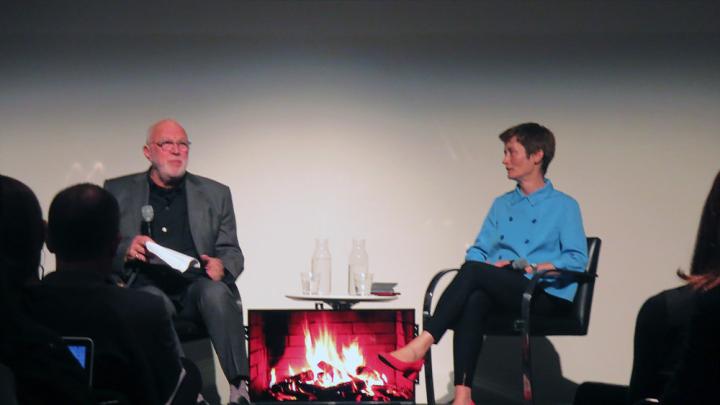Graduate School of Design (GSD) dean Sarah Whiting, newly arrived this past summer, and Noyes professor of architectural theory K. Michael Hays—who has known the dean for decades, as her teacher, editorial collaborator, and academic colleague—conducted a community fireside chat with faculty and staff members and students at Piper Auditorium last night. The stage was set with a projected virtual fireplace in full blaze, an interesting design mash-up in the modernist, concrete auditorium, and perhaps an apt symbol for the creative fizz that the school engenders. Hays, as interlocutor, leaned heavily toward architectural history and theory, his fields and his obvious passions. Whiting, lively and crisp in response, drew on their common past experiences: at Princeton (where she took her master of architecture degree, after her undergraduate education at Yale and before her MIT Ph.D.), and at Assemblage, the influential architectural-theory journal where Hays was founder and co-editor and appointed her as reviews editor. She sketched some of her emerging opinions about and priorities for the GSD, where she has previously taught but now has returned as leader of the whole enterprise.
“There isn’t one dominant paradigm”
Hays noted that Whiting’s early architectural studies and practice coincided with the early 1990s’ challenge to the postmodernist paradigm. Whiting said, teasingly, that speaking extemporaneously as a theorist/historian, Hays’s “footnotes are not always precise,” but that the work he did, and the frameworks he explicated, were always “liberating” for thinking and writing in the design disciplines. Both themes—approaching work in design, and analyzing it—recurred in her subsequent discussion of the school’s mission and opportunities.
Commenting on some of the decisive articles and texts Hays cited—including some of her own—Whiting said she had very much enjoyed her work writing and editing, and viewed “language as a form of construction.” Design writing, she asserted, is critical to “building arguments in a design context,” a kind of architecture in itself (and by implication, just the thing for a school which embraces teaching in practice; research and theory; and critical analysis). In the aftermath of postmodernism, she continued, architectural discourse had sometimes suffered from looking too inward, and descending to facile, formulaic critiques and solutions. In fact, architecture overlaps, is affected by, and affects other disciplines (including socioeconomic ones), which shapes what the designer can do and build.
Since the beginning of this millennium, Whiting continued, “There isn’t one dominant paradigm.” That makes it both easy and difficulty to proceed in a design school: there is no one pole around which to orient one’s teaching and practice—and by the same token, one is not unduly confined or constrained by an overarching approach.
Hays raised the concern that resorting to “disciplinarity” could be reductive for the field’s teaching and practice. Whiting responded that “Our field and design discourse have a tendency to reduce things to easy binaries.…We tend to pit things against each other”: the primacy of form versus social engagement, architecture versus urbanism. That reductionism, she said emphatically, is “incredibly destructive.” Better to think of design practice in terms like “engaged autonomy”: a building necessarily has walls and a form, and a physical shape envisioned by its design creator, but it exists in a context, and has to acknowledge how that context might change. “Disciplinarity,” in that sense, is a positive recognition that every field taught within the GSD has a history—meaning that teachers and students have “a responsibility to understand the context of what you’re interested in, and to project it forward” in future built work. Architecture, landscape design, and urban planning, she explained, did not begin, sui generis, on the day that new students enrolled at the school and began their career preparation. That preparation entails recognizing that “design touches everything and is deeply affected” in turn by social and economic forces, new materials, new technologies, and more. The GSD, she said, “contains a lot of that” sweeping context and knowledge within its corpus.
“Moments of collective intensity”
Turning explicitly to education, Hays wondered whether, with the proliferation of techniques that design students everywhere feel compelled to learn, the school’s commitment to a core sequence of courses in skills, theory, technical content, and professional practice and ethics could continue to stand up. As he put it most vividly, a “core” curriculum could suffer from the same fate as a humanities “canon,” withering under various critiques.
Whiting—who was dean at Rice, has taught at Princeton, the University of Kentucky, the Illinois Institute of Technology, and the University of Florida, and worked in three leading architectural practices and founded her own—drew on all that experience to present the counterargument. Many schools, she said, have reduced their core courses, and (in effect) outsourced much of their education to the reputation of visiting critics who evaluate students’ studio and thesis work. The GSD, in contrast, has insisted on three- and four-semester course sequences, including a “long core in history and theory,” technologies, and so on. Although she expects to review the evolving state of those core sequences during the coming year, Whiting said, their contents remain important to each of the school’s three central programs. She played with the idea of retagging the “core” as a “commons” or “common platform,” but is committed to strong, broad preparation for architecture, landscape architecture, and urban-design students so they can encounter one another’s fields at the GSD, and emerge strongly prepared with “a lot of options” as professionals.
One of the GSD’s strengths, in fact, is its size and critical mass, which enable it to offer this kind of comprehensive education. Compared to smaller, more intimate design schools, like Princeton’s, she said later, she hoped that here, “We can find ways to have moments of collective intensity about topics,” as with the evening’s fireside chat.
“We are obliged to be relevant”
As the audience pitched in, one member asked how the design profession could respond to climate change, given the “failure of our political-economic imagination” to cope with it. Whiting said design professionals, alone, could not provide the solution. The subject, she said, “should permeate the curriculum, rather than being isolated as a course unto itself.” That did not mean reducing the GSD’s education to a single focus on climate change: the “commons” sequences should not be about the fiscal, structural, and climate contexts for design per se, she continued. Rather, in a student’s early studios, it would be natural to draw connections by having a critic ask, for example, “Have you thought about where those materials came from?” In upper-level studios, students would then be better prepared to address climate concerns explicitly and comprehensively.
Similarly, when asked how design students could approach, say, rapidly changing technologies, concerns about privacy, and other issues arising in society, Whiting said it was important for designers to engage with “cultural history,” and cited some of the relevant literature. But as someone who has both written about architecture and practiced it, she hastened to say that such considerations had to be bounded at some point. The designer’s job is to determine how, say, public and private space are mediated in design, in a specific project that is her area of focus and expertise; the designer’s job is not to be expert in all those other fields, which are others’ domain.
How could students be taught in an age overwhelmed with information and distractions from social media and the Internet? Whiting said it was the faculty’s obligation to “introduce time and close reading into all facets of the curriculum.” If a student turned to, say, an example from Instagram, the faculty member’s role was to use it if it tied to the context of the material under study—and if not, to turn it aside. The GSD, she said, is “teaching a more profound way of paying attention to everything”—including, perhaps, students’ own eventual social-media channels, which should be the best-designed, most thoughtful examples of the form, reflecting their own education and close attention to such matters.
Reverting to the earlier conversation about the current moment for design teaching and practice in the wake of postmodernism, an audience member asked whether there was a “meta narrative” or alternative paradigm for the GSD today. Whiting thought that was impossible. Rather, she said, designers’ chief obligation was to look forward. Turning to theory and critique, she advanced the notion of a “tentative totality”: the obligation of each designer to advance her or his views of a project, while remaining responsible to the wider context—whether the “hard reality” of climate change or other considerations. It would not suffice to be subsumed solely by inwardly directed critique, or devoted solely to economic or political concerns. As designers, she said, perhaps formulating the heart of the profession and its challenging trade-offs, “We are obliged to be relevant.”







